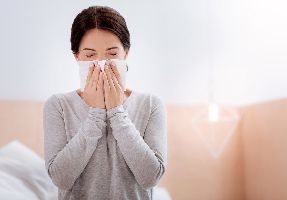Reviewed by Phillip Waite, Ph.D.

Winter is a part of the year when indoor activities seem to increase while outdoor excursions tend to become a thing of the past. This is mostly due to colder temperatures and the ice and snow that bring delayed commutes. Colds and flu become more prevalent during this time because of the increase in indoor activity. Aside from spreading and catching illnesses all year round, your home contains more bacteria, viruses, allergens, and dust during the winter season.
Less outdoor air flows into your home because you are too busy trying to keep the house warm. This leads to an increase in allergic reactions, requires more sanitizing efforts, and demands more dusting. Some ways to help combat those uninvited inhabitants include the use of air purifiers and dusters that reduce air pollutants, rather than promote them. Vacuums can help too, depending on their design and performance. Here are some great ways to clean the air and help promote a healthier environment for everyone.
Use Air Purifiers and Filtration Systems
The best way to reduce and help control all the dust, bacteria, viruses, and allergens is to use air purifiers throughout the home.
Common air purifier types include:
• Tabletop air purifiers
• Floor models
• Ceiling-mounted purification systems
• Small plug-in wall units
Air purification levels vary from one model to the next. The higher the microns, the more it filters. Generally speaking, bacteria and allergen filtration levels for the unit should be around .3 microns for best performance. Staphylococcus bacteria carry a size as low as .7 micron while dust mite allergens can go as low as .1 micron. Most unhealthy, airborne particles range in size between .3 and 1.0, so try to find units that filter particles close to that range. Small plugin purifiers probably won’t have that wide of a filtering range, but they still help clean the air in small areas like an office corner, and they don’t cost much energy to run.
Use the Right Duster
Dusters come in all shapes and sizes, as well as types. The worst thing you can do is spread the dust and allergens around. Pet dander, textile dust, bacteria, dust mites, feces, mold spores, and more can get pushed into the air, which can affect the lungs and throat. Those with Asthma will suffer the most, but the contaminants can affect anyone and lead to cardiovascular disease, headaches, dizziness, fatigue, nausea, and/or sickness.
It is always best to use microfiber dusters such as Swiffer Dusters. Microfiber cloths are another option. They grab contaminants and hold them in place so that they do not spread in the air. For areas up high, the extendable microfiber dusters are perfect, and you can clean those dirty ceiling fan blades too. Brooms just make things worse.
Use a High-Quality HEPA Vacuum
A good quality vacuum is one that features high-efficiency particulate air (HEPA) filtration. However, that doesn’t mean it is good for the home. Some cheaper models have gaps and cracks that allow some allergens and dust to escape, especially at the location where the canister attaches. In addition, they may not have as good of a filtration level as more expensive models. Regardless of what you use, any HEPA vacuum is better than a standard one.
In addition to HEPA benefits and design, the vacuum should have attachments such as a crevice tool and a brush tool. The crevice tool picks up hiding debris and dust in those tight areas and along walls and windows where viruses, bacteria, and dust mites easily hide. The brush attachment wipes allergens and other contaminants off surfaces, while the vacuum draws them in so they do not disburse into the air. On another note, rotary brush attachments are another accessory, commonly used for furniture, and they work great to draw in particles when used slowly. Any fast action can push bacteria and particles into the air before the attachment gets the chance to draw them in.
Use Your Windows to Clean the Home’s Air Whenever Possible
It may be cold outside in the winter, but windows are perhaps the most efficient way to clear the home of allergens, bacteria, dust, and other air pollutants. It works best when there are several windows open so old air can move out while fresh air moves in.
Window fans will provide the best air-cleaning results. Set them to exhaust the air, mostly because it forces the contaminants to flow out of the home. But again, other windows need to be opened to ensure fresh air comes in or you’ll just awaken the resting air pollutants that are living with you. Since the house will cool down as the cold air moves in, consider running a window fan when you will be away for a couple hours. Even if you do this for just 30 minutes, you still help reduce pollutants in the home. A little bit of open time is better than none at all, and it makes a big difference.
Use Humidifiers
Part of the problem with indoor air during winter is that it dries out from all the warmth being kicked out by the furnace. Dry air leads to allergic flare-ups from breathing in dust mites, bacteria, viruses, and allergens. Humidifiers keep your throat and nasal passageways moist to capture those unhealthy airborne particles and fight colds/flu and other illnesses more effectively.
Humidity also moistens surfaces, making it easier to capture airborne particles. That can help clear the air, but you’ll have more dusting and wiping work to do. In addition, the moisture helps prevent indoor plants from drying out, and those plants help filter and clean the air too. Regardless of any additional wiping and dusting, it is well worth the effort when you and your guests have more energy, and less illness and fatigue.
Use High-Quality Furnace/HVAC Filters
Those cheap, blue filters in the store that cost from $1.00 to $5.00 tend to waste time and money. They don’t filter small particles, especially those unhealthy airborne ones. This leads to more dust and allergens in the home that requires more work to maintain the air. It also leads to more airborne viruses and unhealthy contaminants. A good HVAC/furnace air filter will capture fine particles and exhaust cleaner air throughout the home, delivering fewer allergens, bacteria, and viruses for your occupants to inhale.
You’ll find many furnace filters with descriptive labels such as allergy, ultra-allergen, advanced allergen, dust, odor, and more. What you really need to know is the filter’s Minimum Efficiency Reporting Value (MERV) rating. MERV was developed in 1987 as an international standard by The American Society of Heating, Refrigerating and Air-Conditioning Engineers (ASHRAE®), a global group of engineers, filter manufacturers, and filtration distributors. The MERV scale ranges from one to twenty, and it’s based on the filter’s ability to remove select particles and particle sizes from the air. Most households use filters with MERV 8-12 ratings. Higher ratings will filter more allergens, bacteria, and viruses because they capture tinier particles. For occupants with asthma, a MERV 12 filter is best. Allergy sufferers may get away with using a MERV 11 filter.
Aside from MERV ratings, Filtrete® by 3M® uses their own filtration scale, known as Micro-Particle Performance Rating (MPR), and Home Depot uses a Filter Performance Rating (FPR) system. Filtrete’s MPR ranges from 300-2800. An MPR rating of 300 is comparable to MERV 6 while MPR 1000 is similar to MERV 11. Home Depot’s FPR scale ranges from four to ten. An FPR 9 rating is similar to MERV 11 because it claims to filter many of the same particles. An FPR 7 can be comparable to a MERV 6 rating because it also filters particles like lint, dust mites, mold, and pollen.
In reality, there is no way to completely eliminate dust, hair follicles, bacteria, viruses, allergens, dust mites, and other airborne pollutants. However, you can control them with the right air purifiers, window fans, safe cleaning techniques, and quality cleaning products. The ultimate goal is to trap as many harmful air particles as possible while kicking the rest out of your home through the windows.
Did you find this article helpful? Join us at HealingWell for support and information about Allergies. Connect and share with others like you.


